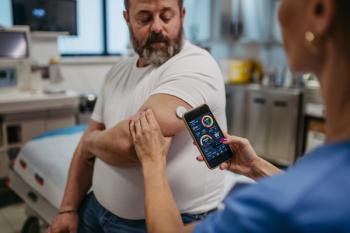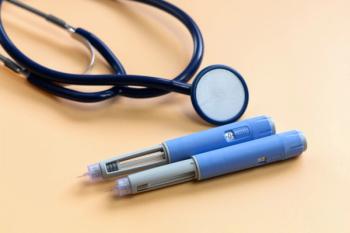
- May 2011 Skin & Eye Health
- Volume 77
- Issue 5
Diabetes Watch
Brought to you by
CCBs Have Similar Outcomes to ARBs in Diabetic Patients
Can calcium channel blockers (CCBs) be used for hypertension control in patients with type 2 diabetes just as effectively as angiotensin-converting enzyme (ACE) inhibitors or angiotensin receptor blockers (ARBs)?
The NAGOYA HEART study, results of which were presented at the American College of Cardiology Scientific Sessions Summit in New Orleans, found no difference between the ARB valsartan and the CCB amlodipine in patients with type 2 diabetes. The primary end point of the study was a composite outcome of acute myocardial infarction, stroke, coronary revascularization, heart failure hospitalization, or sudden cardiac death over 3 years.
The randomized trial enrolled 1150 patients from Japan with hypertension, 82% of whom were diabetic, and treated them with either valsartan or amlodipine to achieve a blood pressure goal of less than 130/80 mm Hg. The researchers found that the composite end point occurred in 9.4% of patients taking valsartan and 9.7% of those taking amlodipine hazard ratio [HR] 0.97, 95% confidence interval [CI] 0.66-1.4, P = .85). Although CCBs may be associated with similar primary outcomes as ACE inhibitors and ARBs, many guidelines recommend initial therapy with an ACE inhibitor or an ARB because of the added benefit of preventing microvascular complications like albuminuria and nephropathy; CCBs have not been shown as extensively to have this nephroprotective effect.
New Guidelines Published for Treatment of Diabetic Neuropathy
In a joint effort, the American Academy of Neurology, the American Association of Neuromuscular and Electrodiagnostic Medicine, and the American Academy of Physical Medicine and Rehabilitation published their guidelines for treating painful diabetic neuropathy (PDN) in May’s issue of the journal Neurology. Using a systematic review of the literature from 1960 to August 2008, the researchers stratified 79 studies based on strength and effect size of the trials.
They found an ample amount of evidence to recommend pregabalin as first-line therapy for patients presenting with PDN, although other anticonvulsants, including gabapentin and valproic acid, are viable alternatives. They also found that in patients who cannot tolerate anticonvulsants, antidepressants such as amitriptyline, venlafaxine, and duloxetine should be considered. Although their chronic use is associated with tolerance and novel pain syndromes like rebound headache, the opioids dextromethorphan and tramadol could be considered as alternatives to pregabalin as well. Finally, although there are limited studies evaluating its use, topical capsaicin is another option that can be used in combination with other medications when treating PDN.
The scientists hope that further studies will be of longer duration, utilize formal rating pain scales, study cost-effectiveness of the medications, and measure effect on quality of life and physical function.
Diet Soda Not Linked to Diabetes
Although it is known that consumption of sugar-sweetened beverages is a risk factor for type 2 diabetes, the jury is still out regarding artificially sweetened beverages like diet soda. Prior studies have shown conflicting evidence regarding an association between type 2 diabetes and artificially sweetened beverages.
Researchers from Harvard School of Public Health sought a more definitive answer to this question. Published online in the American Society of Nutrition journal on March 23, their prospective cohort study included 40,389 healthy men from the Health Professionals Follow-Up study. Cumulative average intakes of sugar-sweetened (sodas, fruit punches, fruit drinks, and lemonades) and artificially sweetened (diet soda, diet drinks) beverages were calculated from questionnaires over a span of 20 years. These intakes were then tested for associations with type 2 diabetes using Cox regression analysis.
After 20 years of follow-up, the researchers found there were 2680 cases of type 2 diabetes. Adjustments were made for age, family history, high triglycerides at baseline, hypertension, and other possible confounders. Intake of sugarsweetened beverages was significantly associated with type 2 diabetes (HR 1.24, 95% CI 1.09-1.42, P <.01), whereas intake of artificially sweetened beverages was not (HR 1.09, 95% CI 0.98- 1.21, P = .13).
Interestingly, the researchers also found an added risk reduction of 17% when substituting unsweetened coffee for sugarsweetened beverages. They attribute this to the presence in coffee of magnesium and flavonoids, 2 antioxidants beneficial to overall health and insulin sensitivity. PT
Articles in this issue
over 14 years ago
CDC Invites DIY Developers to Tackle Fluover 14 years ago
Patients Donate Data to Fuel Health Researchover 14 years ago
Generic Drugs Slash Out-of-Pocket Costsover 14 years ago
FTC Reports Uptick in Pay-For-Delay Dealsover 14 years ago
Ten REMS Throw Retirement Partyover 14 years ago
A Day in the Life: Dealing with Cancerover 14 years ago
What Do ACOs Mean for Specialty Pharmacy Practice?over 14 years ago
Oncology: Are You on the Right Path Through the Brewing Storm?over 14 years ago
Raising the BarNewsletter
Stay informed on drug updates, treatment guidelines, and pharmacy practice trends—subscribe to Pharmacy Times for weekly clinical insights.


















































































































































































































